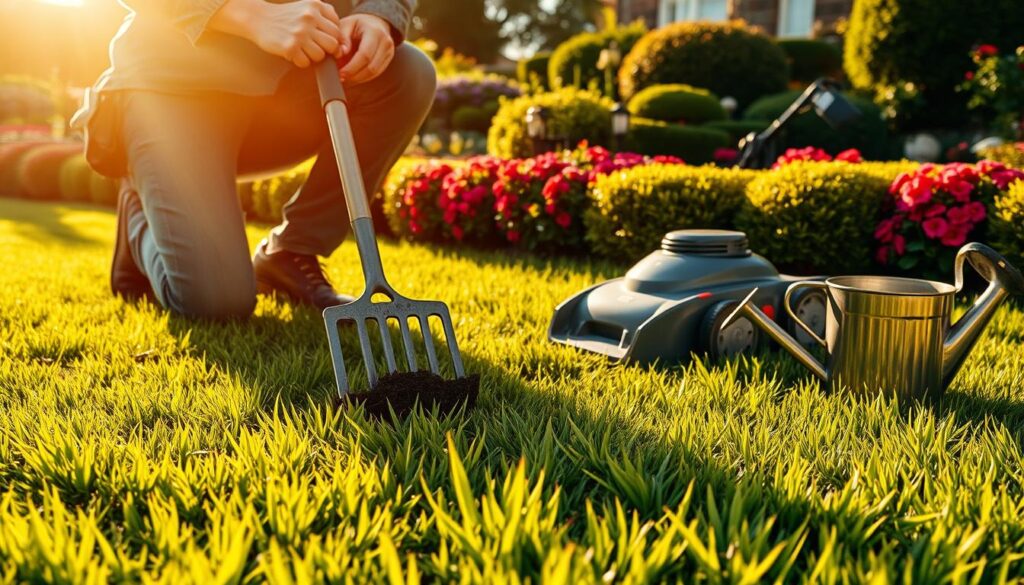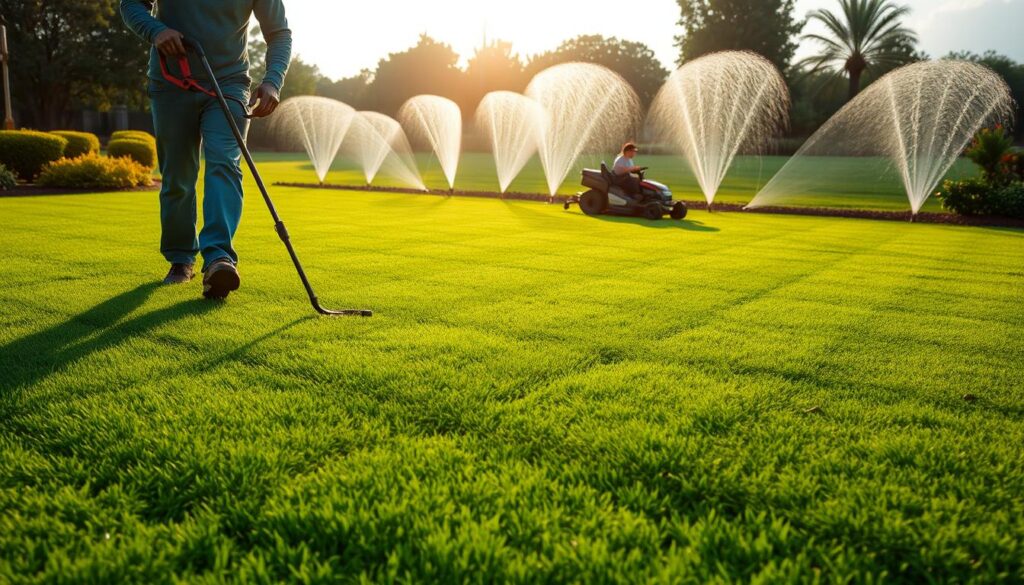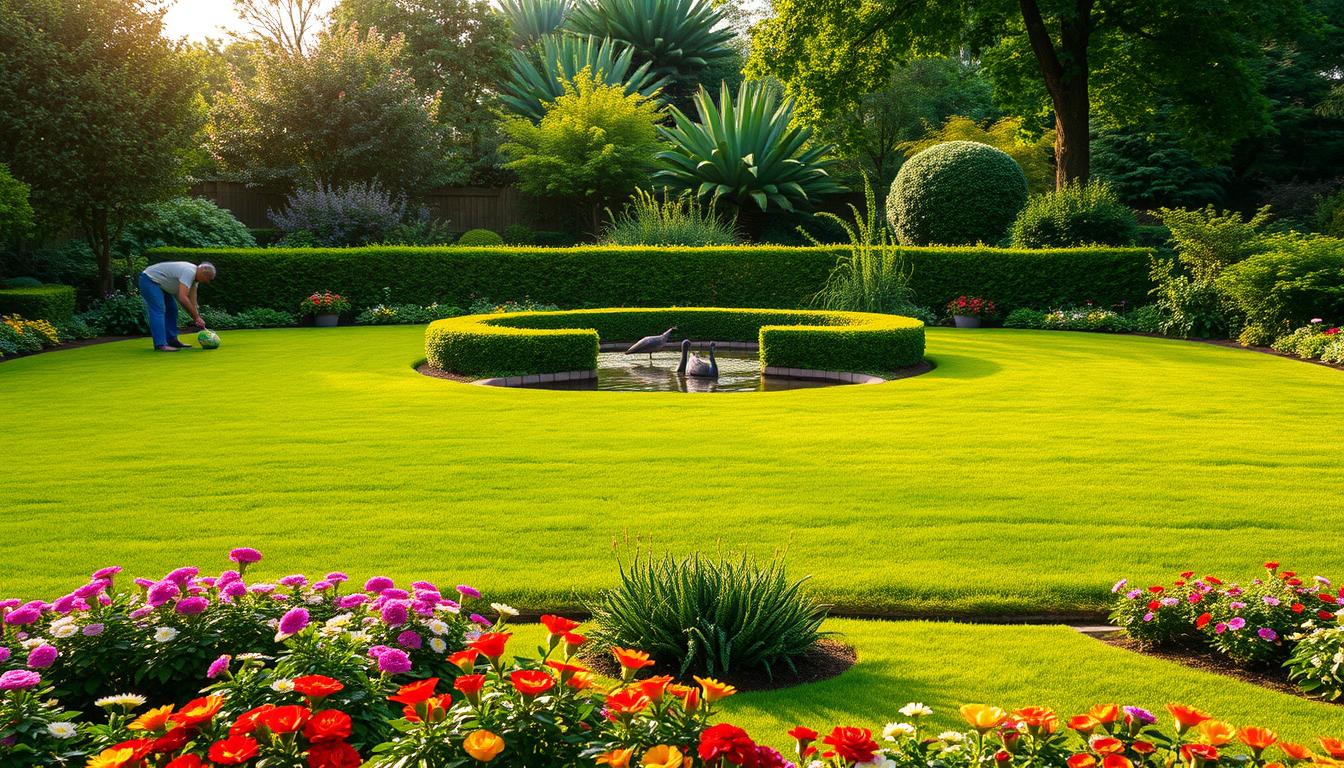Are you ready to turn your outdoor space into a thriving, eco-friendly haven? Modern techniques can help you create a garden that’s not only beautiful but also sustainable. By replacing traditional grass with native plants, you can reduce water usage and support local ecosystems.
Healthy soil is the foundation of any successful project. Proper preparation ensures your plants get the nutrients they need to thrive. Consider your regional climate and USDA hardiness zones to choose the best plants for your area.
This guide covers 18 actionable techniques, from landscaping ideas to soil enrichment tips. Whether you’re growing fresh produce or creating a space for family activities, these methods will enhance your outdoor experience. Plus, you’ll enjoy year-round benefits like reduced maintenance and increased property value.
Key Takeaways
- Modern techniques make your outdoor space eco-friendly and functional.
- Replacing traditional grass with native plants saves water and supports ecosystems.
- Healthy soil is essential for plant growth and nutrient absorption.
- Consider your climate and USDA hardiness zones for plant success.
- Transform your yard into a space for family activities and homegrown produce.
Introduction to Lawn Gardening
Discover how to blend beauty and functionality in your outdoor space. Lawn gardening is a hybrid approach that combines turfgrass with functional garden areas. Unlike traditional monoculture lawns, this method promotes biodiversity and sustainability.

What is Lawn Gardening?
Lawn gardening merges the best of both worlds: the lush appeal of grass and the practicality of plants. It’s about creating a space that’s not only visually pleasing but also environmentally friendly. This approach often includes areas for growing fruits, herbs, or flowers alongside turf.
Benefits of Lawn Gardening
This method offers numerous advantages:
- Supports pollinators like bees and butterflies.
- Enables homegrown food production.
- Reduces allergy triggers compared to traditional lawns.
- Lowers your carbon footprint.
- Adds unique curb appeal to your home.
Understanding Your Yard’s Potential
Assessing your outdoor space is crucial. Use chalk spray mapping to track sunlight patterns and identify the best spots for planting. For pet owners, consider urine-resistant grass zones to maintain a healthy yard.
Programs like the UGA Extension’s Soil and Water Testing Services provide personalized analysis to optimize your soil health. Avoid artificial turf, which, while low-maintenance, contributes to microplastic pollution. Instead, focus on natural solutions like reseeding every two years to maintain density.
For inspiration, look to Oregon State University’s lasagna gardening method, which layers organic materials for enriched soil and thriving plants.
Essential Lawn Gardening Techniques
Master the basics of maintaining a healthy and vibrant yard. These techniques ensure your outdoor space thrives while conserving resources and supporting local ecosystems. From soil preparation to efficient watering, each step plays a crucial role in achieving a lush, sustainable environment.

Soil Testing and Preparation
Healthy plants start with healthy soil. A soil test is the first step to understanding your yard’s needs. Aim for a pH level between 6.0 and 6.5 for optimal growth. Professional lab tests are more accurate than DIY kits and provide detailed recommendations for improving nutrients.
Use a screwdriver to check moisture levels before sampling. Avoid mixing sand and clay, as this can create a concrete-like texture. Instead, focus on organic amendments like compost to enhance soil quality.
Choosing the Right Grass
Selecting the best grass for your region is key. Warm-season varieties thrive in southern climates, while cool-season types are ideal for northern areas. Refer to the USDA zone map to make an informed decision.
Research disease-resistant cultivars, such as those studied by UGA’s Turfgrass Production program. These options reduce maintenance and ensure long-term health.
Watering and Irrigation Tips
Efficient watering saves resources and keeps your plants healthy. Use the tuna-can method to measure ½ inch of water per session. This ensures deep root growth without overwatering.
Implement hydrozoning by grouping plants with similar water needs. This strategy minimizes waste and maximizes efficiency. For more tips, check out this beginner’s guide to gardening.
Mowing and Maintenance
Proper mowing techniques promote healthy growth. During drought or stress periods, keep your grass at 3 inches to encourage deeper roots. Use a mulching mower to recycle clippings, which provide 1 pound of nitrogen per 1,000 square feet annually.
Regular maintenance, like aerating and dethatching, ensures your yard stays vibrant year-round. These practices improve air and nutrients flow to the roots.
| Technique | Key Benefit |
|---|---|
| Soil Testing | Identifies nutrient needs for healthy plants |
| Hydrozoning | Reduces water waste |
| Mulching Mower | Recycles nutrients from clippings |
Advanced Lawn Care Strategies
Take your yard to the next level with advanced care strategies. These techniques go beyond the basics to ensure your outdoor space remains healthy, vibrant, and sustainable. From fertilizing to pest control, these methods address complex challenges effectively.

Fertilizing Your Lawn
Proper fertilization is key to maintaining lush, green grass. Use the formula of 1 pound of nitrogen per 1,000 square feet for optimal results. Fall is the best time to fertilize, as it prepares your yard for a strong spring green-up.
Compare organic options like compost tea with synthetic fertilizers. Organic materials improve soil health over time, while synthetic options provide quick nutrients.
Dealing with Pests and Diseases
Common pests like chinch bugs, armyworms, grubs, moles, and fire ants can damage your yard. Integrated Pest Management (IPM) strategies offer a sustainable way to control these issues.
Resources like UGA’s Plant Pest and Disease Management programs provide valuable information for identifying and treating infestations.
Aerating and Dethatching
Power dethatching removes over ½ inch of thatch, which manual tools can’t handle. Use OSU’s screwdriver compaction test to determine if your yard needs aeration.
These practices improve air and water flow to the roots, promoting healthier grass.
Seasonal Lawn Care
Adjust your care routine based on the climate and season. Spring is ideal for dethatching, while fall is perfect for overseeding. Late-fall mowing helps prevent snow mold, ensuring a healthy yard year-round.
- Spring: Focus on dethatching and early fertilization.
- Summer: Monitor for pests and water efficiently.
- Fall: Overseed and apply fall fertilizer.
- Winter: Mow late to prevent snow mold.
Creative Landscaping Ideas
Transform your outdoor space into a stunning retreat with creative landscaping ideas. Whether you’re designing a serene escape or a functional garden, these techniques will elevate your home’s curb appeal and sustainability.

Incorporating Native Plants
Native plants are a smart choice for any landscape. They thrive in local climates, require less water, and support pollinators like bees and butterflies. Popular options include purple coneflower, switchgrass, and black-eyed Susan.
Rain gardens, which use 85% native plants, are an excellent way to reduce flooding in wet areas. These eco-friendly designs also add beauty and biodiversity to your outdoor space.
Designing with Turfgrass
Turfgrass can be both functional and visually appealing. Use patterning techniques to create unique designs that add interest to your yard. For example, alternating mowing directions can create a striped effect.
Choose disease-resistant varieties to minimize maintenance. This ensures your landscape stays lush and healthy throughout the year.
Adding Garden Beds and Pathways
Raised garden beds are ideal for growing fruits, vegetables, and flowers. Optimal dimensions are 16 inches wide and 12 inches deep, providing ample space for root growth.
Mulched pathways should be at least 2.5 feet wide for accessibility. This not only enhances the look of your garden but also prevents soil compaction.
Using Mulch for Aesthetic and Health Benefits
Mulch is a versatile material that improves soil health and adds visual appeal. Compare options like cedar and cocoa bean hulls to find the best fit for your needs.
Edible landscaping is another creative way to use mulch. For example, blueberry border hedges provide both beauty and a delicious harvest.
Hardscaping materials like gravel, pavers, and rubber mulch offer different benefits. Consider cost and durability when choosing the right materials for your project.
Conclusion
Ready to elevate your outdoor space with proven strategies? By focusing on soil testing, hydrozoning, and integrating native plants, you can create a thriving, eco-friendly garden. A typical $500 renovation can save you $1,200 over five years, making it a smart investment for your family and the environment.
Start by submitting a soil test and exploring resources like UGA Extension’s Master Gardener programs or 4-H workshops. These programs teach sustainable practices that benefit your health and local ecosystems. Avoid common mistakes like over-fertilization or improper mowing heights to ensure long-term success.
Share your before-and-after photos to inspire others. With these changes, you could see a 200% increase in pollinators, transforming your yard into a haven for nature and food production. Take the first step today and watch your outdoor space flourish!

